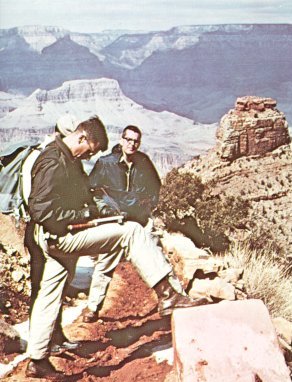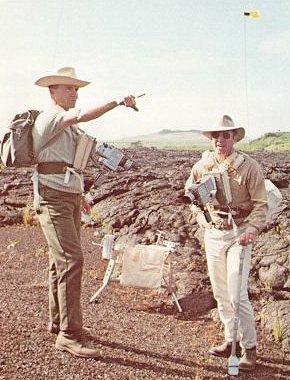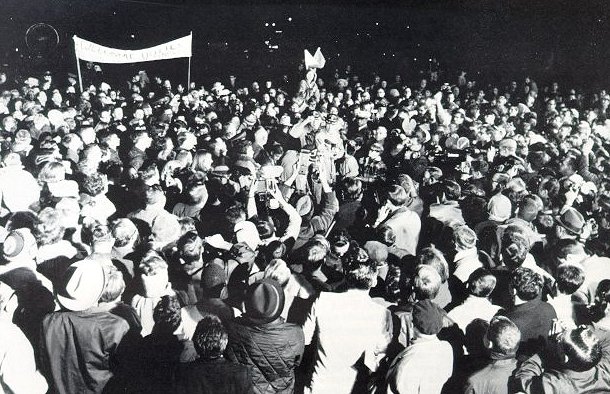Apollo Expeditions to the Moon
TRAINING CREWS AND CONTROLLERS
Astronaut training and development of the flight plans and crew procedures were
directed by Deke Slayton. He accomplished these tasks in an outstanding manner.
The training that Deke provided the crews, as well as the training provided the flight
controllers, gave them the capability to react to the unexpected. Quite often it resulted
in unique training devices and equipment. The zero-gravity environment was simulated
by using a modified KC-135 aircraft that flew parabolas, thus creating 20 to 30
seconds of weightlessness. A neutral buoyancy water tank was also used to simulate the
weightless environment. The unique Lunar Landing Training Vehicle (LLTV) was
developed to train the astronauts in controlling the lunar module during the final
phase of its descent and landing. The test flights of the LLTV, for example, saw the
successful emergency ejection of three pilots - Joe Algranti and Stu Present, research
pilots, and Neil Armstrong, the commander of the first lunar landing mission - because
of vehicle failures. Bob Gilruth and I both believed that flying this craft was
more hazardous than flying the actual lunar module.

|
Astronauts and their instructor take notes on their field
observations during a geology training trip into the Grand
Canyon, in Arizona. Although the rocks that are exposed
at the Grand Canyon do not resemble lunar rocks in any
way, the trip here was an important step in familiarizing
the astronauts with the basics of geology, so that they
could function well as observers and collectors.
|

|
Apollo 13 Astronauts Fred Haise and Jim Lovell
observe features of a lava flow near Hilo, Hawaii,
during a geology field training trip. They used such
items of lunar equipment as the handtool carrier behind
them and the Hasselblad cameras mounted on
their chest packs. As fate would have it, this pair did
not have the chance to use their training.
|
Simulators also had to be developed to provide training for the flight crew in the
operation of the spacecraft. These simulators were tied in with the Mission Control
Center so that an integrated training could be accomplished with the flight controllers.
These simulations allowed the flight crew to train realistically for all phases of the
mission, including the landing itself. Unique display techniques were used with actual
models of each landing site. The models allowed the crew to gain familiarity with the
terrain and recognizable landmarks. Detailed lunar maps that were based primarily
on data provided by the NASA unmanned lunar orbit program were prepared by the
Air Force Information and Charting Service and by the U.S. Geological Survey.
As the system matured after Apollo 11, greater emphasis was placed on scientific
training and on ensuring that the astronauts were prepared to perform scientific experiments
when they arrived on the Moon. Prominent scientists both from within the
government and from universities throughout the country offered their time and talent
to ensure that the crew and the Operations Team were adequately trained to perform
the demanding scientitic tasks. During the mission, they also participated as members
of the Operations Team. Apollo brought a new aspect to spaceflight as man on the
surface of the Moon worked in conjunction with a science team on Earth that capitalized
on his observations, judgments, and abilities. They assessed his comments and
evaluations, and modified the science planning and objectives in real time. This was
not accomplished, however, without moments of frustration and anguish during the
early flights, when the acceptability of the spacecraft and its systems was yet to be
proved. During the later lunar missions, the crew and the Operations Team were
working with proven procedures and a proven spacecraft, and the capabilities of the
science organization were effectively integrated in the performance of the missions.
| | |
Although it was past 2 a.m., a crowd of
more than 2000 people was on hand at Ellington
Air Force Base to welcome the members
of the Apollo 8 crew back home. Astronauts
Frank Borman, James Lovell, and William
Anders had just flown to Houston from the
Pacific recovery area by way of Hawaii. The
three crewmen of the first manned lunar-orbit
mission are standing at the microphones in the
center of the picture.
|

|
Apollo 8 crewman Frank Borman gets a
warm greeting from Robert Gilruth, the
Manned Spacecraft Center Director, upon his
arrival at Ellington Air Force Base, just outside
Houston. Looking on is Edwin Borman, the
astronaut's 15-year-old son. William Anders
and his family are in the background.
|
As a means of saying thanks, on March 5, 1973, this group of scientists held a
dinner for a number of the program and operations personnel they had worked with
over the years. The events of that night clearly showed how well this relationship had
developed. As late as 1969, there were very few that would have been brave enough to
predict such a dinner would have ever occurred.
|




